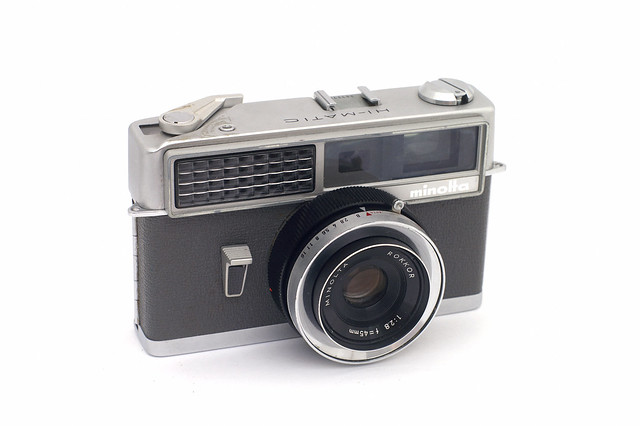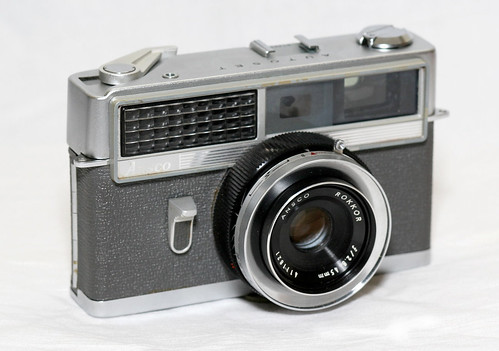Difference between revisions of "Minolta Hi-Matic"
Hanskerensky (talk | contribs) (Added image author and rights) |
(deleted some markup that seemed funky; adding pic of Ansco variant; smoothing clumsy phrasing) |
||
| Line 1: | Line 1: | ||
{{Flickr_image | {{Flickr_image | ||
|image_source= http://www.flickr.com/photos/captkodak/271906449/in/pool-camerawiki | |image_source= http://www.flickr.com/photos/captkodak/271906449/in/pool-camerawiki | ||
| − | |image= http://farm1.static.flickr.com/99/ | + | |image= http://farm1.static.flickr.com/99/271906449_b4338ed633_z.jpg |
| − | |image_align= | + | |image_align= right |
| − | |image_text= | + | |image_text= Standard-setting 1962 rangefinder |
|image_by= Steve Harwood | |image_by= Steve Harwood | ||
|image_rights= non-commercial | |image_rights= non-commercial | ||
}} | }} | ||
| − | + | The '''Minolta Hi-Matic''' camera redefined [[Minolta]]'s series of budget [[rangefinder camera]]s, superseding the [[Minolta Uniomat|Uniomat]] and [[Minolta Uniomat II |Uniomat II]]. The Hi-Matics always had an automatic exposure mode. The original Hi-Matic model controlled this via a [[selenium meter]], and offered a flash mode with shutter speed 1/30 sec. and manual aperture control. This model became famous in its [[Ansco]] OEM version, the '''Ansco Autoset''', as one of the cameras that Astronaut John Glenn used during his space flight. | |
| − | + | ||
| − | + | Later Hi-Matics had [[CdS]] meters (beginning with the [[Minolta Hi-Matic 7|Hi-Matic 7]]), with the meter cell always placed within the filter ring. | |
| − | === | + | |
| + | |||
| + | ===Specifications=== | ||
* Type: rangefinder camera | * Type: rangefinder camera | ||
* Manufacturer: [[Minolta]] | * Manufacturer: [[Minolta]] | ||
| Line 20: | Line 22: | ||
* Size: 138×84×67 mm | * Size: 138×84×67 mm | ||
* Weight: 740 g | * Weight: 740 g | ||
| − | === | + | ===Later variant=== |
* Lens: 1:2.8/45mm (4 elements) | * Lens: 1:2.8/45mm (4 elements) | ||
| − | |||
| − | + | ||
| − | |} | + | {{Flickr_image |
| + | |image_source= http://www.flickr.com/photos/maderik/4801615872/in/pool-camerawiki | ||
| + | |image= http://farm5.static.flickr.com/4076/4801615872_4d5076412b.jpg | ||
| + | |image_align= left | ||
| + | |image_text= As [[Ansco]] Autoset | ||
| + | |image_by= edjpgcom | ||
| + | |image_rights= cc | ||
| + | }} | ||
[[Category:Minolta|Hi-Matic]] | [[Category:Minolta|Hi-Matic]] | ||
[[Category:H|Hi-Matic]] | [[Category:H|Hi-Matic]] | ||
[[Category:Japanese 35mm rangefinder]] | [[Category:Japanese 35mm rangefinder]] | ||
Revision as of 14:48, 15 September 2011

|
| Standard-setting 1962 rangefinder image by Steve Harwood (Image rights) |
The Minolta Hi-Matic camera redefined Minolta's series of budget rangefinder cameras, superseding the Uniomat and Uniomat II. The Hi-Matics always had an automatic exposure mode. The original Hi-Matic model controlled this via a selenium meter, and offered a flash mode with shutter speed 1/30 sec. and manual aperture control. This model became famous in its Ansco OEM version, the Ansco Autoset, as one of the cameras that Astronaut John Glenn used during his space flight.
Later Hi-Matics had CdS meters (beginning with the Hi-Matic 7), with the meter cell always placed within the filter ring.
Specifications
- Type: rangefinder camera
- Manufacturer: Minolta
- Year of launch: 1962
- Film: 35mm with speeds from 6 to 1600 ASA
- Lens: 1:2.0/45mm (6 elements in 5 groups)
- Shutter: Citizen leaf shutter with meter-controlled aperture/speed combinations from f2 1/45 sec. to f16 1/500sec
- Metering: selenium meter
- Size: 138×84×67 mm
- Weight: 740 g
Later variant
- Lens: 1:2.8/45mm (4 elements)

|
| As Ansco Autoset image by edjpgcom (Image rights) |